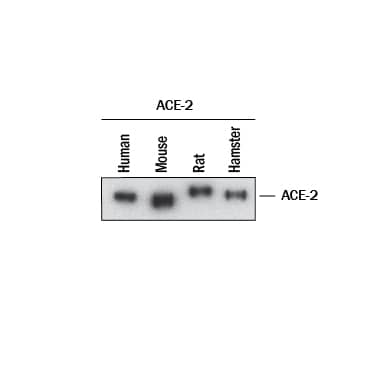Human/Mouse/Rat/Hamster ACE-2 Antibody
R&D Systems, part of Bio-Techne | Catalog # MAB3437

Key Product Details
Species Reactivity
Validated:
Cited:
Applications
Validated:
Cited:
Label
Antibody Source
Product Specifications
Immunogen
Gln18-Thr740 (predicted)
Accession # Q8R0I0
Specificity
Clonality
Host
Isotype
Scientific Data Images for Human/Mouse/Rat/Hamster ACE-2 Antibody
Detection of Human ACE-2 by Western Blot.
Western blot shows lysates of human kidney. PVDF membrane was probed with 0.5 µg/mL of Rat Anti-Human/Mouse/Rat/Hamster ACE-2 Monoclonal Antibody (Catalog # MAB3437) followed by HRP-conjugated Anti-Rat IgG Secondary Antibody (HAF005). A specific band was detected for ACE-2 at approximately 120 kDa (as indicated). This experiment was conducted under reducing conditions and using Western Blot Buffer Group 1.Detection of Human, Mouse, Rat, and Hamster ACE-2 by Western Blot.
Western blot shows recombinant human ACE-2 protein, recombinant mouse ACE-2 protein, recombinant rat ACE-2 protein, and recombinant hamster ACE-2 protein. PVDF membrane was probed with 0.5 µg/mL of Rat Anti-Human/Mouse/Rat/Hamster ACE-2 Monoclonal Antibody (Catalog # MAB3437) followed by HRP-conjugated Anti-Rat IgG Secondary Antibody (HAF005). A specific band was detected for ACE-2 at approximately 120 kDa (as indicated). This experiment was conducted under reducing conditions and using Western Blot Buffer Group 1.Applications for Human/Mouse/Rat/Hamster ACE-2 Antibody
Western Blot
Sample: Human kidney and recombinant human ACE-2 protein, recombinant mouse ACE-2 protein, recombinant rat ACE-2 protein, and recombinant hamster ACE-2 protein
Formulation, Preparation, and Storage
Purification
Reconstitution
Formulation
Shipping
Stability & Storage
- 12 months from date of receipt, -20 to -70 °C as supplied.
- 1 month, 2 to 8 °C under sterile conditions after reconstitution.
- 6 months, -20 to -70 °C under sterile conditions after reconstitution.
Background: ACE-2
ACE-2, also called ACEH (ACE homologue), is an integral membrane protein and a zinc metalloprotease of the ACE family that also includes somatic and germinal ACE (1). Mouse ACE-2 has about 40% amino acid identity to the N- and C-terminal domains of mouse somatic ACE. The predicted mouse ACE-2 protein sequence consists of 798 amino acids, including a N-terminal signal peptide, a single catalytic domain, a C-terminal membrane anchor, and a short cytoplasmic tail. ACE-2 cleaves angiotensins I and II as a carboxypeptidase. ACE-2 mRNA is found at high levels in testis, kidney and heart and at moderate levels in colon, small intestine and ovary. Classical ACE inhibitors such as captopril and lisinopril do not inhibit ACE-2 activity. Novel peptide inhibitors of ACE-2 do not inhibit ACE activity (2). Genetic data from Drosophila, mice and rats show that ACE-2 is an essential regulator of heart function in vivo (3). In addition, ACE-2 is a key SARS-CoV Spike protein receptor in vivo and has a critical function in acute lung injury (4, 5).
References
- Tipnis, S.R. et al. (2000) J. Biol. Chem. 275:33238.
- Crackower, M.A. et al. (2002) Nature 417:822.
- Huang, L. et al. (2003) J. Biol. Chem. 278:15532.
- Kuba, K. et al. (2005) Nature Med. 11:875.
- Ima, Y. et al. (2005) Nature 436:112.
Long Name
Alternate Names
Entrez Gene IDs
Gene Symbol
UniProt
Additional ACE-2 Products
Product Documents for Human/Mouse/Rat/Hamster ACE-2 Antibody
Product Specific Notices for Human/Mouse/Rat/Hamster ACE-2 Antibody
For research use only

